The artistic genius of Pablo Picasso (1881–1973) has impacted the development of modern and contemporary art with unparalleled magnitude. His prolific output includes over 20,000 paintings, prints, drawings, sculptures, ceramics, theater sets and costumes that convey myriad intellectual, political, social, and amorous messages. His creative styles transcend realism and abstraction, Cubism, Neoclassicism, Surrealism, and Expressionism. Born in Malaga, Spain, in 1881, Picasso studied art briefly in Madrid in 1897, then in Barcelona in 1899, where he became closely associated with a group of modernist poets, writers, and artists who gathered at the café Els Quatre Gats (The Four Cats), including the Catalan Carlos Casagemas (1880–1901).
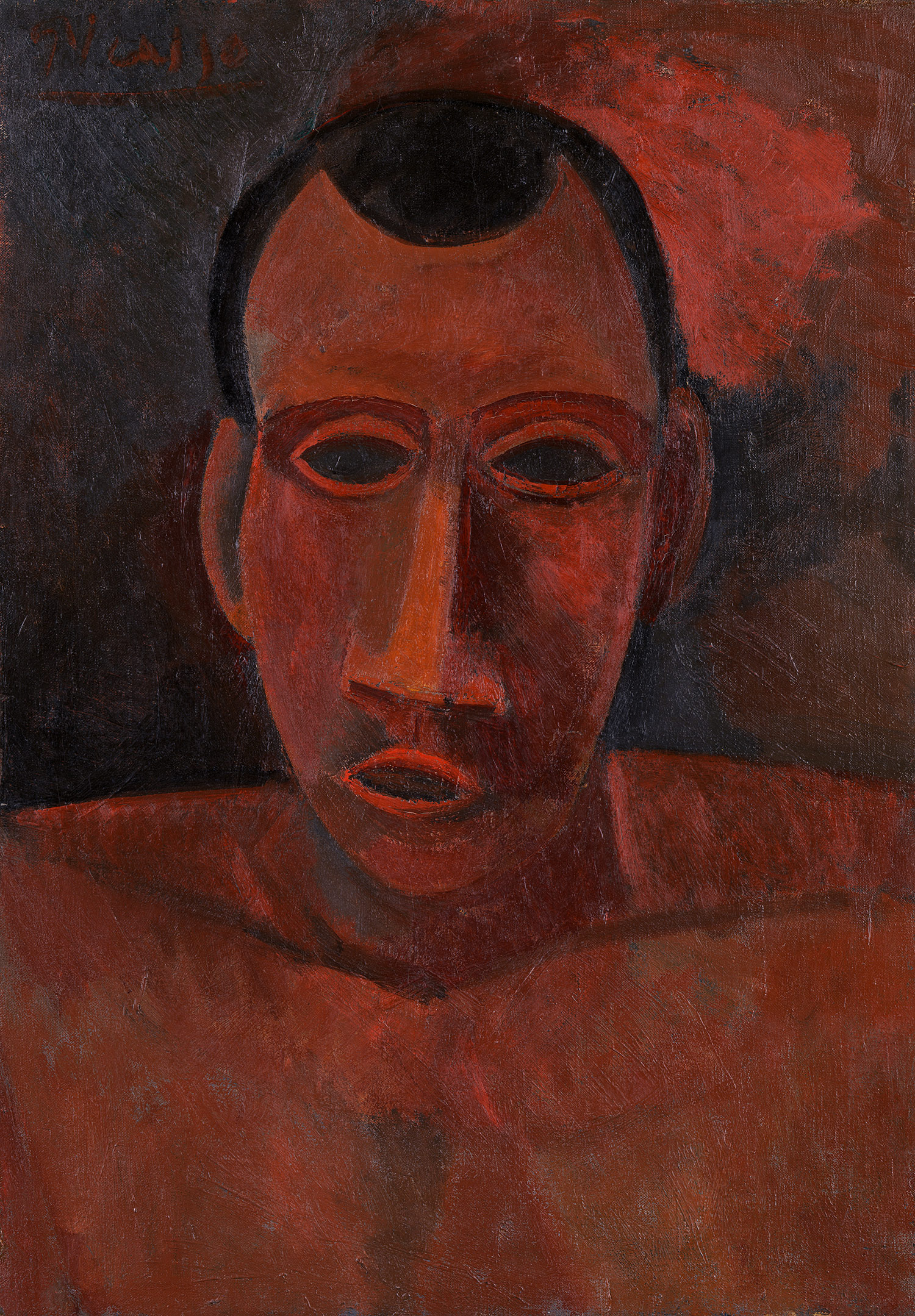
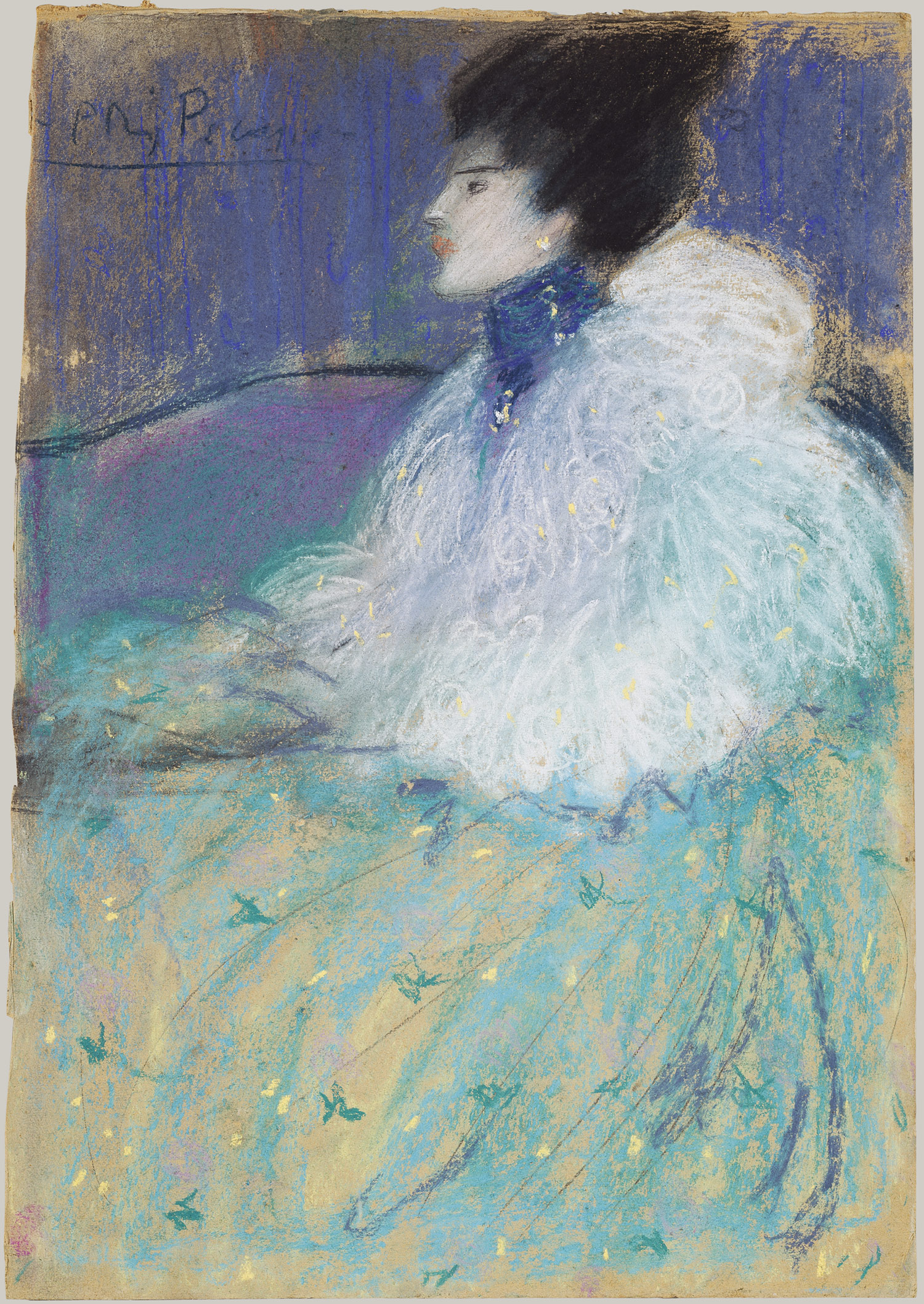 Living intermittently in Paris and Spain until 1904, his work during these years suggests feelings of desolation and darkness inspired in part by the suicide of his friend Casagemas. Picasso's paintings from late 1901 to about the middle of 1904, referred to as his Blue Period, depict themes of poverty, loneliness, and despair. In The Blind Man's Meal (50.188) from 1903, he uses a dismal range of blues to sensitively render a lonely figure encumbered by his condition as he holds a crust of bread in one hand and awkwardly grasps for a pitcher with the other. The elongated, corkscrew bodies of El Greco (1541–1614) inspire the man's distorted features.
Living intermittently in Paris and Spain until 1904, his work during these years suggests feelings of desolation and darkness inspired in part by the suicide of his friend Casagemas. Picasso's paintings from late 1901 to about the middle of 1904, referred to as his Blue Period, depict themes of poverty, loneliness, and despair. In The Blind Man's Meal (50.188) from 1903, he uses a dismal range of blues to sensitively render a lonely figure encumbered by his condition as he holds a crust of bread in one hand and awkwardly grasps for a pitcher with the other. The elongated, corkscrew bodies of El Greco (1541–1614) inspire the man's distorted features.
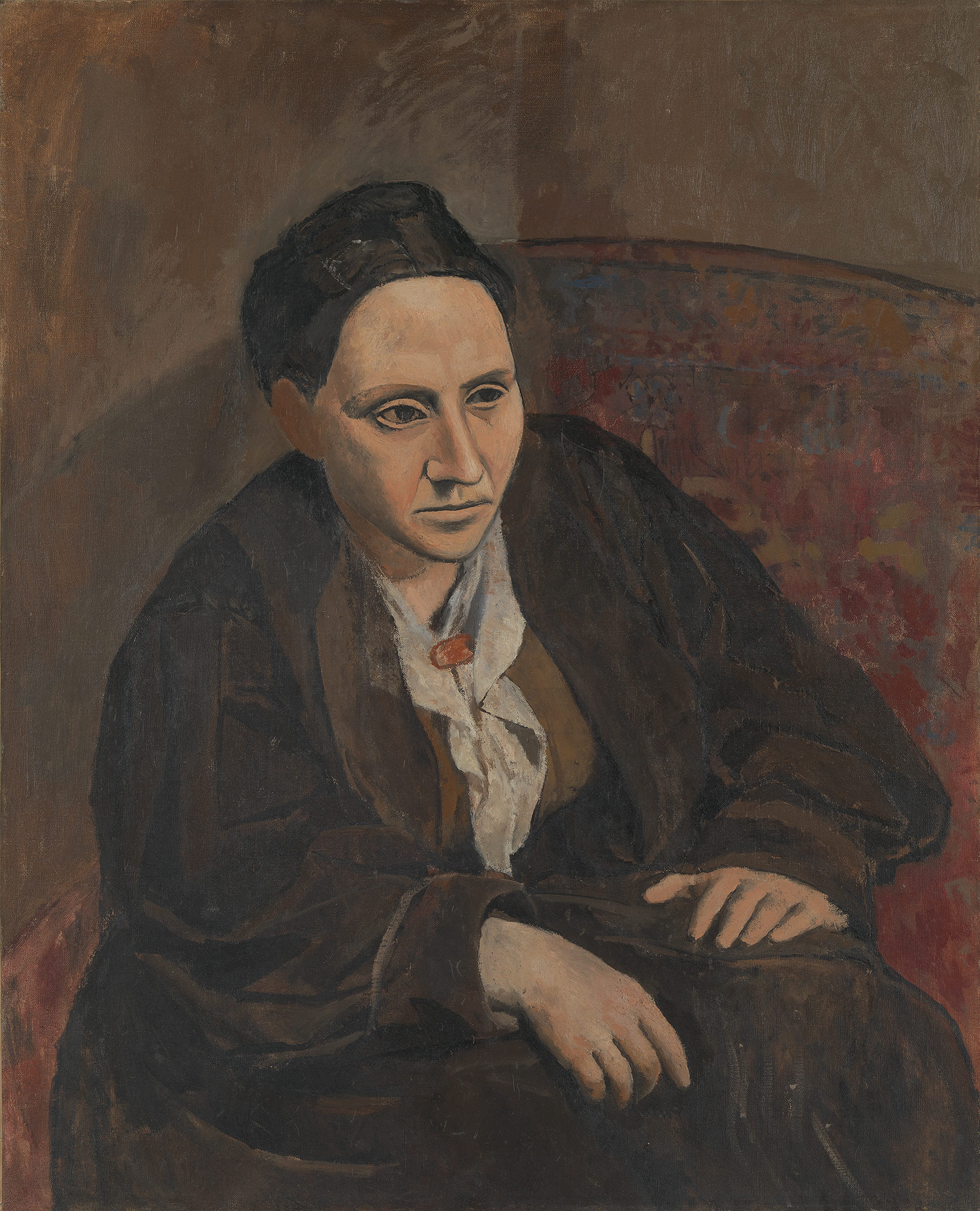

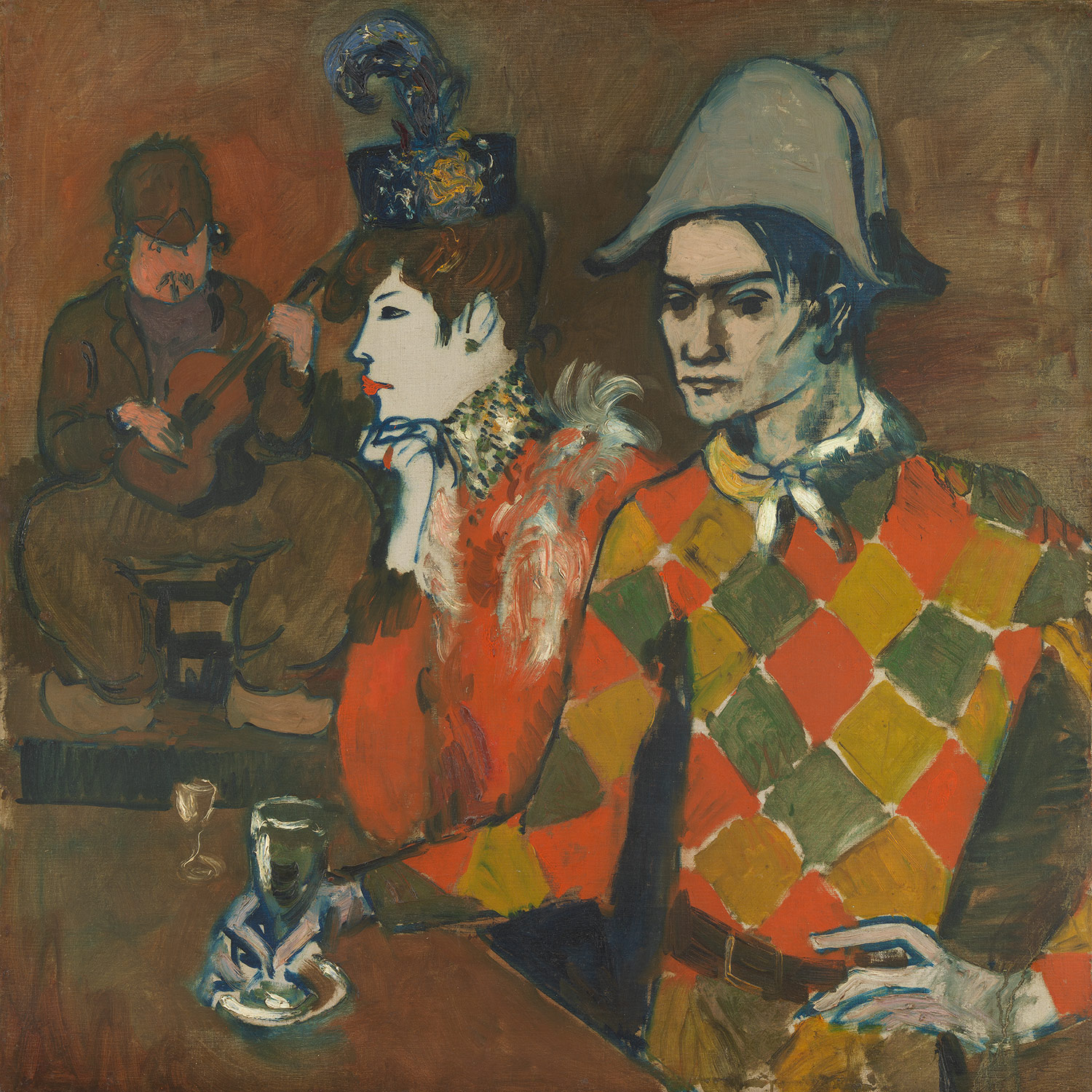 Picasso moved to Paris in 1904 and settled in the artist quarter Bateau-Lavoir, where he lived among bohemian poets and writers such as Guillaume Apollinaire (1880–1918) and Max Jacob (1876–1944). In At the Lapin Agile (1992.391) from 1905, Picasso directs his attention toward more pleasant themes such as carnival performers, harlequins, and clowns. In this painting, he uses his own image for the harlequin figure and abandons the daunting blues in favor of vivid hues, red for example, to celebrate the lives of circus performers (categorically labeled his Rose Period). In Paris, he found dedicated patrons in American siblings Gertrude (1874–1946) and Leo (1872–1947) Stein, whose Saturday evening salons in their home at 27, rue des Fleurus was an incubator for modern artistic and intellectual thought. At the Steins he met other artists living and working in the city—generally referred to as the "School of Paris"—such as Henri Matisse (1869–1954). Painted in 1906, Gertrude Stein (47.106) records Picasso's early stylistic experiments with primitivism influenced by a new fascination with pre-Roman Iberian sculpture and African and Oceanic art. Concentrating on intuition rather than strict observation, and unsatisfied with the features of Stein's face, Picasso reworked her image into a masklike manifestation stimulated by primitivism. The influence of African and Oceanic art is explicit in his masterpiece Les Demoiselles d'Avignon (1907; Museum of Modern Art, New York), a painting that signals the nascent stages of Cubism. Here the figure arrangement recalls Cézanne's compositions of bathers while stylistically it is influenced by primitivism, evident by the angular planes and well-defined contours that create an overall sculptural solidity in the figures.
Picasso moved to Paris in 1904 and settled in the artist quarter Bateau-Lavoir, where he lived among bohemian poets and writers such as Guillaume Apollinaire (1880–1918) and Max Jacob (1876–1944). In At the Lapin Agile (1992.391) from 1905, Picasso directs his attention toward more pleasant themes such as carnival performers, harlequins, and clowns. In this painting, he uses his own image for the harlequin figure and abandons the daunting blues in favor of vivid hues, red for example, to celebrate the lives of circus performers (categorically labeled his Rose Period). In Paris, he found dedicated patrons in American siblings Gertrude (1874–1946) and Leo (1872–1947) Stein, whose Saturday evening salons in their home at 27, rue des Fleurus was an incubator for modern artistic and intellectual thought. At the Steins he met other artists living and working in the city—generally referred to as the "School of Paris"—such as Henri Matisse (1869–1954). Painted in 1906, Gertrude Stein (47.106) records Picasso's early stylistic experiments with primitivism influenced by a new fascination with pre-Roman Iberian sculpture and African and Oceanic art. Concentrating on intuition rather than strict observation, and unsatisfied with the features of Stein's face, Picasso reworked her image into a masklike manifestation stimulated by primitivism. The influence of African and Oceanic art is explicit in his masterpiece Les Demoiselles d'Avignon (1907; Museum of Modern Art, New York), a painting that signals the nascent stages of Cubism. Here the figure arrangement recalls Cézanne's compositions of bathers while stylistically it is influenced by primitivism, evident by the angular planes and well-defined contours that create an overall sculptural solidity in the figures.
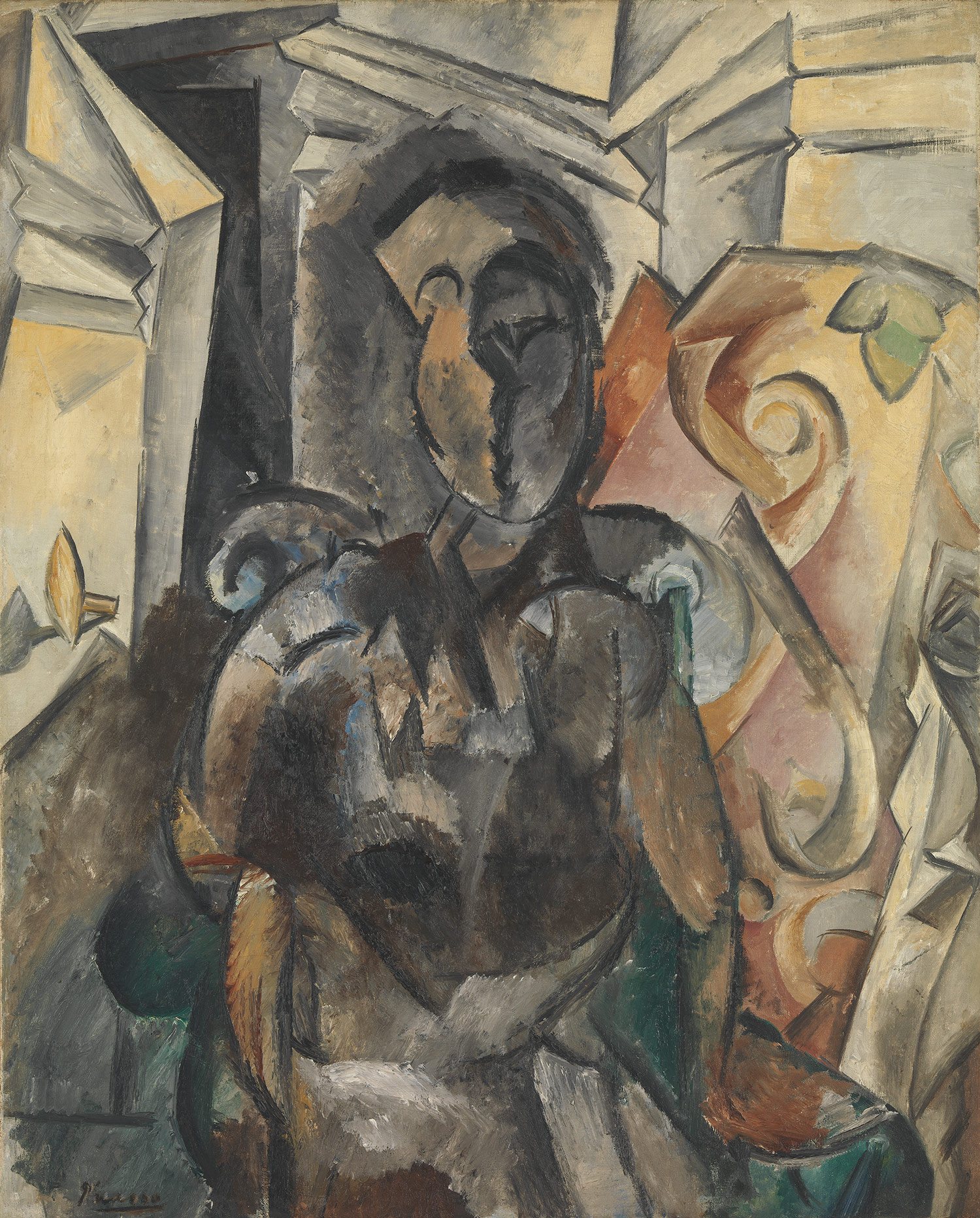 The basic principles of Analytic Cubism (1910–12), with its fragmentation of three-dimensional forms on a two-dimensional picture plane, are embodied in Still Life with a Bottle of Rum (1999.363.63), painted in 1911. The techniques of Analytic Cubism were developed by Picasso and the French artist Georges Braque (1882–1963), who met in 1907. Picasso's Bottle and Wine Glass on a Table (49.70.33) of 1912 is an early example of Synthetic Cubism (1912–13), a papier collé in which he pasted newsprint and colored paper onto canvas. Picasso and Braque also included tactile components such as cloth in their Synthetic Cubist works, and sometimes used trompe-l'oeil effects to create the illusion of real objects and textures, such as the grain of wood.
The basic principles of Analytic Cubism (1910–12), with its fragmentation of three-dimensional forms on a two-dimensional picture plane, are embodied in Still Life with a Bottle of Rum (1999.363.63), painted in 1911. The techniques of Analytic Cubism were developed by Picasso and the French artist Georges Braque (1882–1963), who met in 1907. Picasso's Bottle and Wine Glass on a Table (49.70.33) of 1912 is an early example of Synthetic Cubism (1912–13), a papier collé in which he pasted newsprint and colored paper onto canvas. Picasso and Braque also included tactile components such as cloth in their Synthetic Cubist works, and sometimes used trompe-l'oeil effects to create the illusion of real objects and textures, such as the grain of wood.
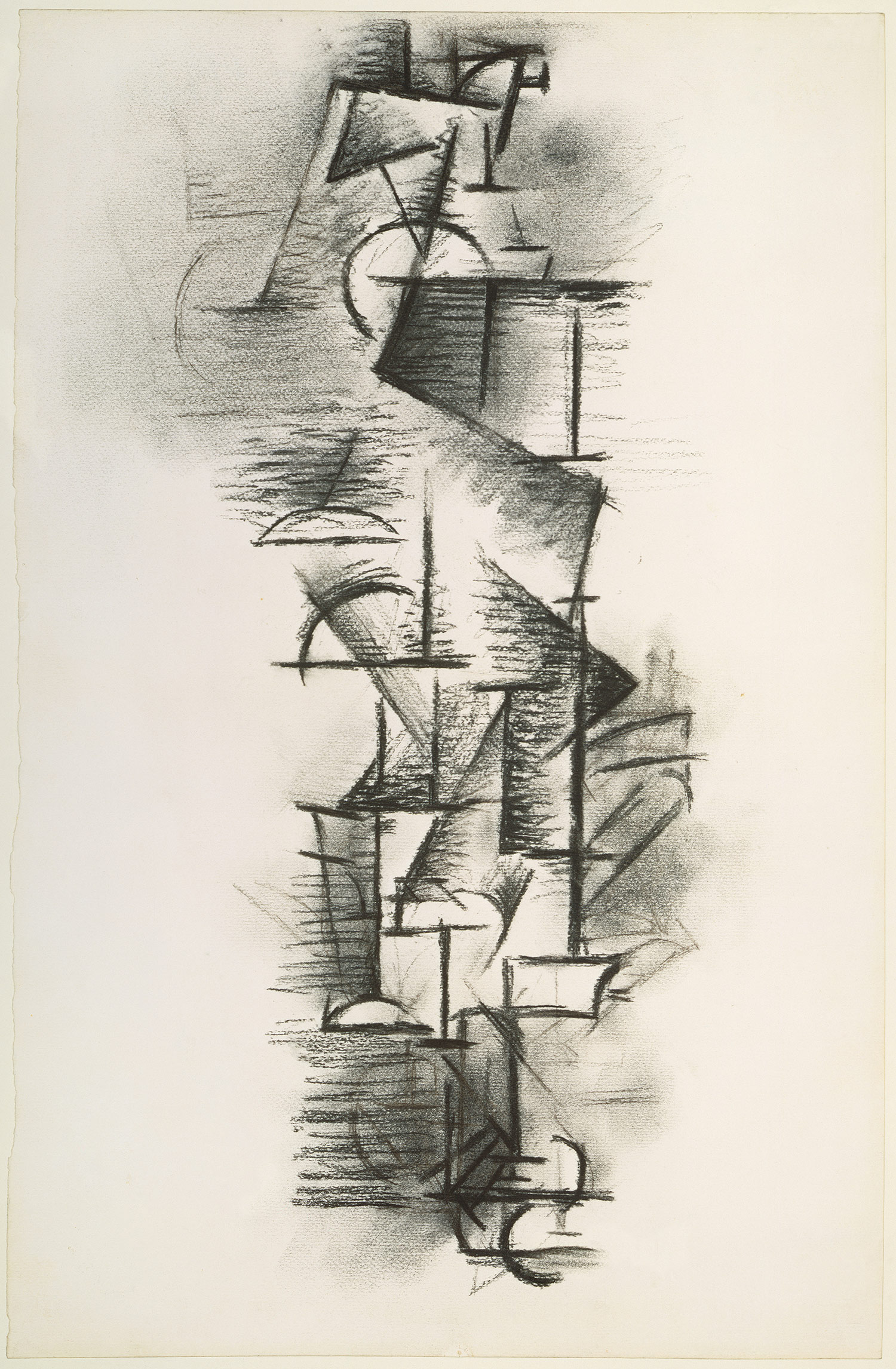 After World War I (1914–18), Picasso reverted to traditional styles, experimenting less with Cubism. In the early 1920s, he devised a unique variant of classicism using mythological images such as centaurs, minotaurs, nymphs, and fauns inspired by the classical world of Italy. Within this renewed expression, referred to as his Neoclassical Period, he created pictures dedicated to motherhood inspired by the birth of his son Paulo in 1921 (his first of four children by three women). Woman in White (53.140.4) of 1923 shows a woman clothed in a classic, toga-like, white dress resting calmly in a contemplative pose with tousled hair, eliciting a tender lyricism and calming spirit of maternity. Toward the end of the 1920s, Picasso drew on Surrealist imagery and techniques to make pictures of morphed and distorted figures. In Nude Standing by the Sea (1996.403.4) of 1929, Picasso's figure recounts the classical pose of a standing nude with her arms upraised, but her body is swollen and monstrously rearranged.
After World War I (1914–18), Picasso reverted to traditional styles, experimenting less with Cubism. In the early 1920s, he devised a unique variant of classicism using mythological images such as centaurs, minotaurs, nymphs, and fauns inspired by the classical world of Italy. Within this renewed expression, referred to as his Neoclassical Period, he created pictures dedicated to motherhood inspired by the birth of his son Paulo in 1921 (his first of four children by three women). Woman in White (53.140.4) of 1923 shows a woman clothed in a classic, toga-like, white dress resting calmly in a contemplative pose with tousled hair, eliciting a tender lyricism and calming spirit of maternity. Toward the end of the 1920s, Picasso drew on Surrealist imagery and techniques to make pictures of morphed and distorted figures. In Nude Standing by the Sea (1996.403.4) of 1929, Picasso's figure recounts the classical pose of a standing nude with her arms upraised, but her body is swollen and monstrously rearranged.
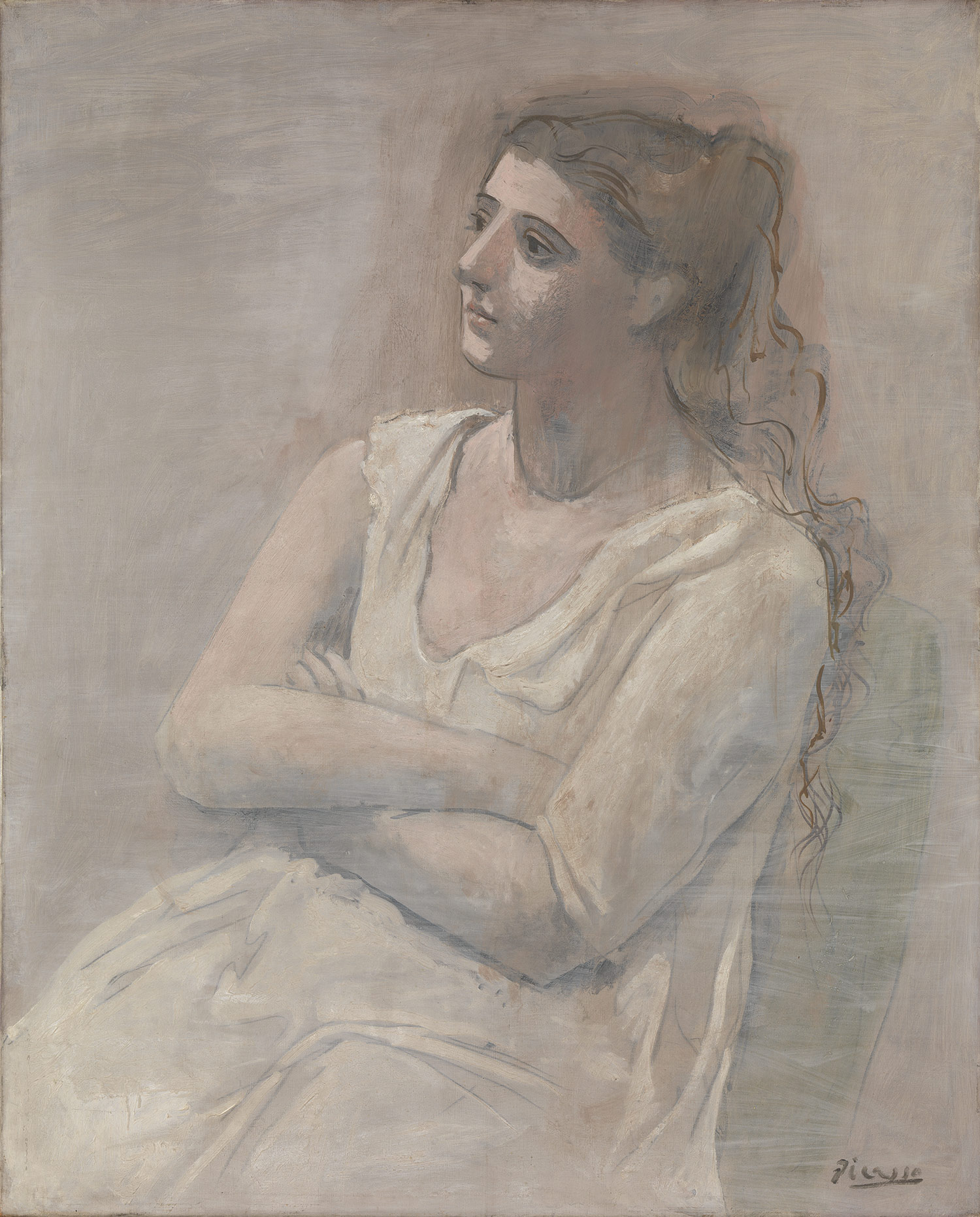
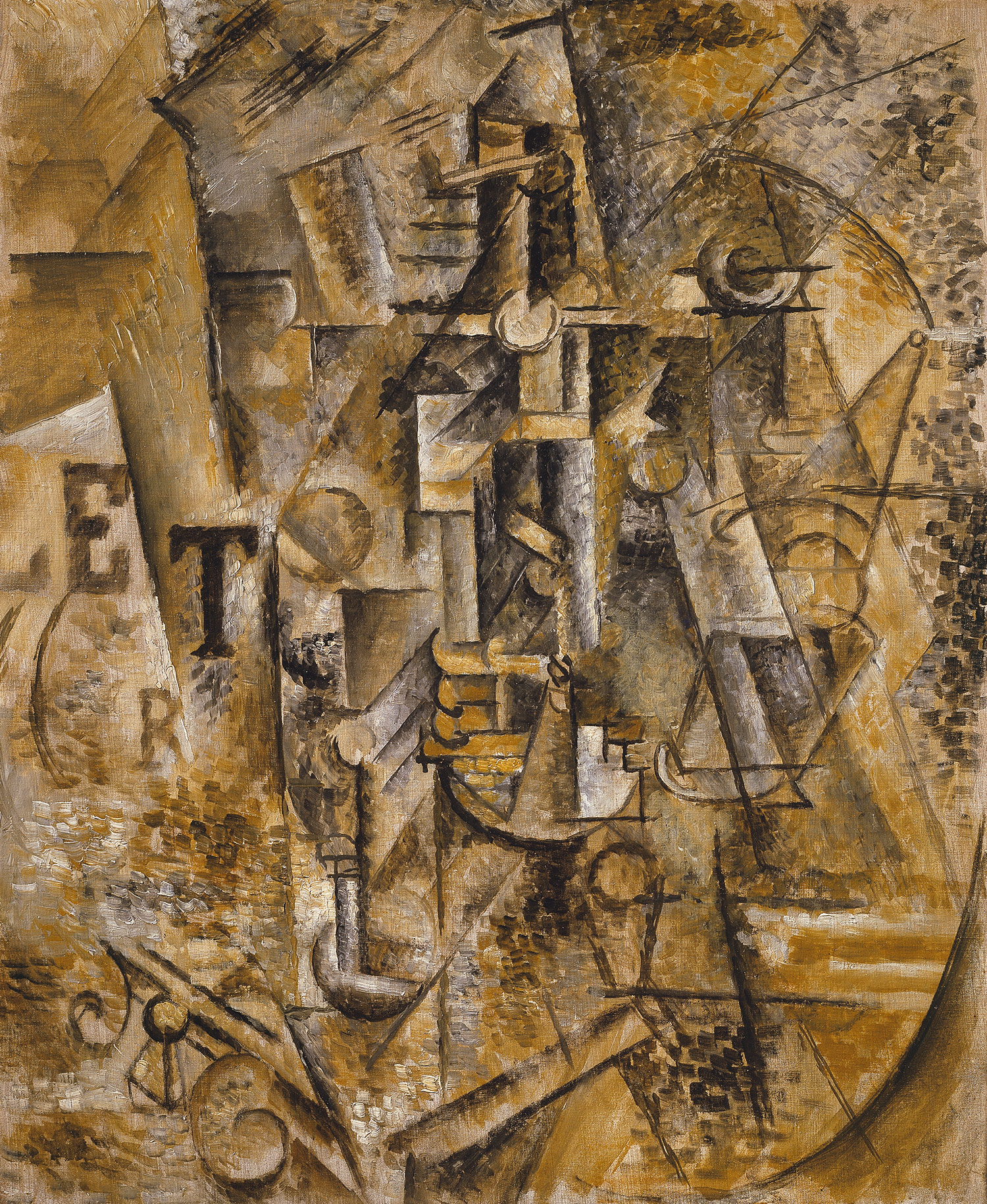 By the early 1930s, Picasso had turned to harmonious colors and sinuous contours that evoke an overall biomorphic sensuality. He painted scenes of women with drooping heads and striking voluptuousness with a renewed sense of optimism and liberty, probably inspired by his affair with a young woman (one of Picasso's numerous mistresses) named Marie-Thérèse Walter (1909–1977). Girl Reading at a Table (1996.403.1) from 1934 uses these expressive qualities of bold colors and gentle curves to portray Marie-Thérèse seated at an oversized table, emphasizing her youth and innocence.
By the early 1930s, Picasso had turned to harmonious colors and sinuous contours that evoke an overall biomorphic sensuality. He painted scenes of women with drooping heads and striking voluptuousness with a renewed sense of optimism and liberty, probably inspired by his affair with a young woman (one of Picasso's numerous mistresses) named Marie-Thérèse Walter (1909–1977). Girl Reading at a Table (1996.403.1) from 1934 uses these expressive qualities of bold colors and gentle curves to portray Marie-Thérèse seated at an oversized table, emphasizing her youth and innocence.
Although still living in France in the 1930s, Picasso was deeply distraught over the outbreak of the Spanish Civil War in 1936. He reacted with a powerfully emotive series of pictures, such as The Dream and Lie of Franco (1986.1224.1[2]), that culminated in the enormous mural Guernica (1937; Reina Sofía National Museum, Madrid), painted in a grisaille palette of gray tones. This painting, Picasso's contribution to the Spanish Pavilion in the 1937 Exposition Universelle in Paris, is a complex work of horrifying proportion with layers of antiwar symbolism protesting the fascist coup led by Generalissimo Francisco Franco.
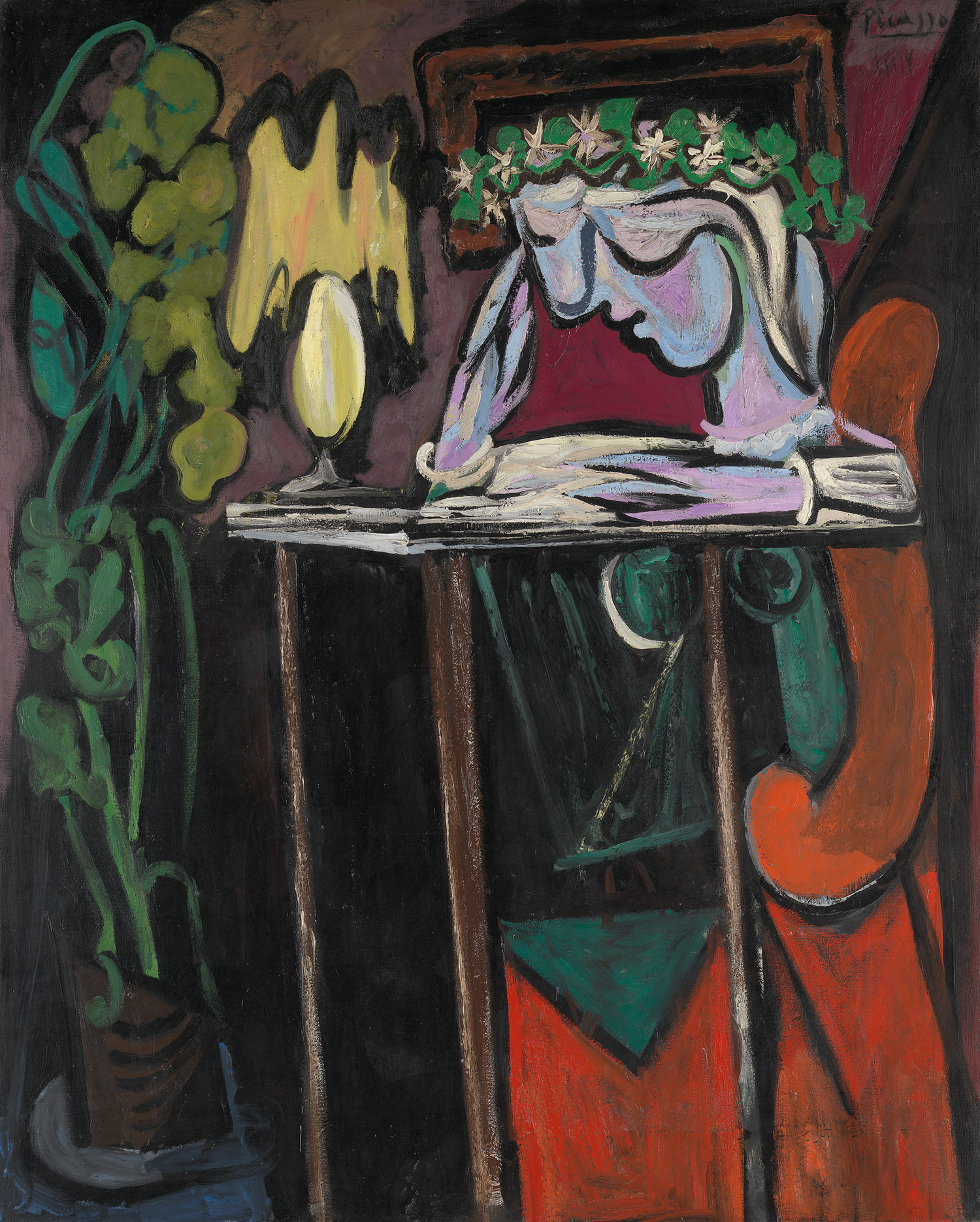 From the late 1940s through the '60s, Picasso's creative energy never waned. Living in the south of France, he continued to paint, make ceramics, and experiment with printmaking. His international fame increased with large exhibitions in London, Venice, and Paris, as well as retrospectives in Tokyo in 1951, and Lyon, Rome, Milan, and São Paulo in 1953. A retrospective in New York at the Museum of Modern Art in 1957 garnered a massive amount of attention, with over 100,000 visitors during the first month. This exhibition solidified Picasso's prominence as museums and private collectors in America, Europe, and Japan vied to acquire his works.
From the late 1940s through the '60s, Picasso's creative energy never waned. Living in the south of France, he continued to paint, make ceramics, and experiment with printmaking. His international fame increased with large exhibitions in London, Venice, and Paris, as well as retrospectives in Tokyo in 1951, and Lyon, Rome, Milan, and São Paulo in 1953. A retrospective in New York at the Museum of Modern Art in 1957 garnered a massive amount of attention, with over 100,000 visitors during the first month. This exhibition solidified Picasso's prominence as museums and private collectors in America, Europe, and Japan vied to acquire his works.
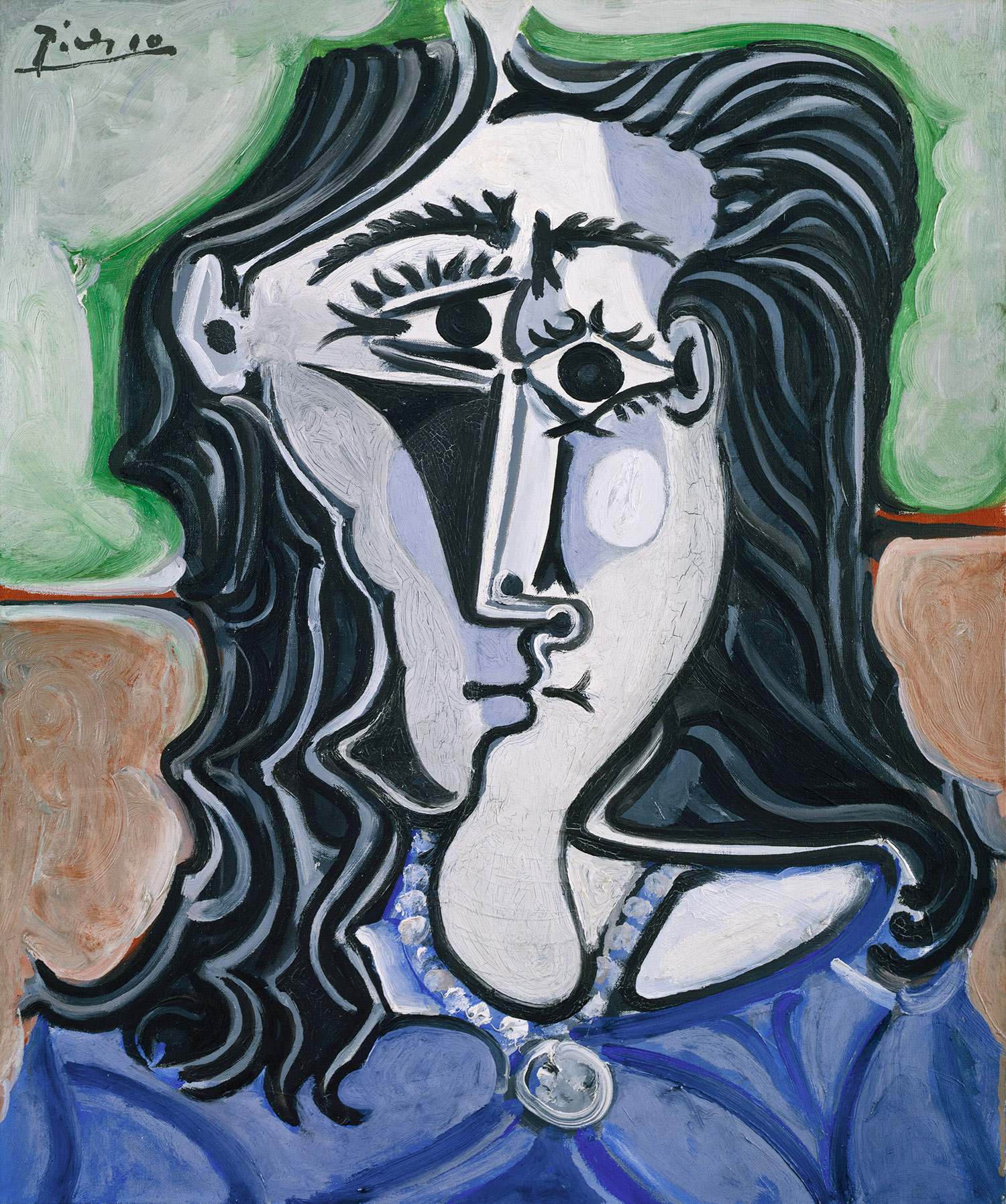 In Faun and Starry Night (1970.305) from 1955, Picasso returned to the mythological themes explored in early pictures. Again, incorporating life experience into his painting, he evokes his infatuation with a new love, a young woman named Jacqueline Roque (1927–1986), who became his second wife in 1961 when the artist was seventy-nine years old. In this painting, Picasso symbolizes himself as a faun, calmly and coolly gazing with mature confidence and wisdom at a nymph who blows her instrument to the stars. The picture embraces his spellbound love for Jacqueline.
In Faun and Starry Night (1970.305) from 1955, Picasso returned to the mythological themes explored in early pictures. Again, incorporating life experience into his painting, he evokes his infatuation with a new love, a young woman named Jacqueline Roque (1927–1986), who became his second wife in 1961 when the artist was seventy-nine years old. In this painting, Picasso symbolizes himself as a faun, calmly and coolly gazing with mature confidence and wisdom at a nymph who blows her instrument to the stars. The picture embraces his spellbound love for Jacqueline.
Even into his eighties and nineties, Picasso produced an enormous number of works and reaped the financial benefits of his success, amassing a personal fortune and a superb collection of his own art, as well as work by other artists. He died in 1973, leaving an artistic legacy that continues to resonate today throughout the world.

 Living intermittently in Paris and Spain until 1904, his work during these years suggests feelings of desolation and darkness inspired in part by the suicide of his friend Casagemas. Picasso's paintings from late 1901 to about the middle of 1904, referred to as his Blue Period, depict themes of poverty, loneliness, and despair. In The Blind Man's Meal (50.188) from 1903, he uses a dismal range of blues to sensitively render a lonely figure encumbered by his condition as he holds a crust of bread in one hand and awkwardly grasps for a pitcher with the other. The elongated, corkscrew bodies of El Greco (1541–1614) inspire the man's distorted features.
Living intermittently in Paris and Spain until 1904, his work during these years suggests feelings of desolation and darkness inspired in part by the suicide of his friend Casagemas. Picasso's paintings from late 1901 to about the middle of 1904, referred to as his Blue Period, depict themes of poverty, loneliness, and despair. In The Blind Man's Meal (50.188) from 1903, he uses a dismal range of blues to sensitively render a lonely figure encumbered by his condition as he holds a crust of bread in one hand and awkwardly grasps for a pitcher with the other. The elongated, corkscrew bodies of El Greco (1541–1614) inspire the man's distorted features.

 Picasso moved to Paris in 1904 and settled in the artist quarter Bateau-Lavoir, where he lived among bohemian poets and writers such as Guillaume Apollinaire (1880–1918) and Max Jacob (1876–1944). In At the Lapin Agile (1992.391) from 1905, Picasso directs his attention toward more pleasant themes such as carnival performers, harlequins, and clowns. In this painting, he uses his own image for the harlequin figure and abandons the daunting blues in favor of vivid hues, red for example, to celebrate the lives of circus performers (categorically labeled his Rose Period). In Paris, he found dedicated patrons in American siblings Gertrude (1874–1946) and Leo (1872–1947) Stein, whose Saturday evening salons in their home at 27, rue des Fleurus was an incubator for modern artistic and intellectual thought. At the Steins he met other artists living and working in the city—generally referred to as the "School of Paris"—such as Henri Matisse (1869–1954). Painted in 1906, Gertrude Stein (47.106) records Picasso's early stylistic experiments with primitivism influenced by a new fascination with pre-Roman Iberian sculpture and African and Oceanic art. Concentrating on intuition rather than strict observation, and unsatisfied with the features of Stein's face, Picasso reworked her image into a masklike manifestation stimulated by primitivism. The influence of African and Oceanic art is explicit in his masterpiece Les Demoiselles d'Avignon (1907; Museum of Modern Art, New York), a painting that signals the nascent stages of Cubism. Here the figure arrangement recalls Cézanne's compositions of bathers while stylistically it is influenced by primitivism, evident by the angular planes and well-defined contours that create an overall sculptural solidity in the figures.
Picasso moved to Paris in 1904 and settled in the artist quarter Bateau-Lavoir, where he lived among bohemian poets and writers such as Guillaume Apollinaire (1880–1918) and Max Jacob (1876–1944). In At the Lapin Agile (1992.391) from 1905, Picasso directs his attention toward more pleasant themes such as carnival performers, harlequins, and clowns. In this painting, he uses his own image for the harlequin figure and abandons the daunting blues in favor of vivid hues, red for example, to celebrate the lives of circus performers (categorically labeled his Rose Period). In Paris, he found dedicated patrons in American siblings Gertrude (1874–1946) and Leo (1872–1947) Stein, whose Saturday evening salons in their home at 27, rue des Fleurus was an incubator for modern artistic and intellectual thought. At the Steins he met other artists living and working in the city—generally referred to as the "School of Paris"—such as Henri Matisse (1869–1954). Painted in 1906, Gertrude Stein (47.106) records Picasso's early stylistic experiments with primitivism influenced by a new fascination with pre-Roman Iberian sculpture and African and Oceanic art. Concentrating on intuition rather than strict observation, and unsatisfied with the features of Stein's face, Picasso reworked her image into a masklike manifestation stimulated by primitivism. The influence of African and Oceanic art is explicit in his masterpiece Les Demoiselles d'Avignon (1907; Museum of Modern Art, New York), a painting that signals the nascent stages of Cubism. Here the figure arrangement recalls Cézanne's compositions of bathers while stylistically it is influenced by primitivism, evident by the angular planes and well-defined contours that create an overall sculptural solidity in the figures. The basic principles of Analytic Cubism (1910–12), with its fragmentation of three-dimensional forms on a two-dimensional picture plane, are embodied in Still Life with a Bottle of Rum (1999.363.63), painted in 1911. The techniques of Analytic Cubism were developed by Picasso and the French artist Georges Braque (1882–1963), who met in 1907. Picasso's Bottle and Wine Glass on a Table (49.70.33) of 1912 is an early example of Synthetic Cubism (1912–13), a papier collé in which he pasted newsprint and colored paper onto canvas. Picasso and Braque also included tactile components such as cloth in their Synthetic Cubist works, and sometimes used trompe-l'oeil effects to create the illusion of real objects and textures, such as the grain of wood.
The basic principles of Analytic Cubism (1910–12), with its fragmentation of three-dimensional forms on a two-dimensional picture plane, are embodied in Still Life with a Bottle of Rum (1999.363.63), painted in 1911. The techniques of Analytic Cubism were developed by Picasso and the French artist Georges Braque (1882–1963), who met in 1907. Picasso's Bottle and Wine Glass on a Table (49.70.33) of 1912 is an early example of Synthetic Cubism (1912–13), a papier collé in which he pasted newsprint and colored paper onto canvas. Picasso and Braque also included tactile components such as cloth in their Synthetic Cubist works, and sometimes used trompe-l'oeil effects to create the illusion of real objects and textures, such as the grain of wood. After World War I (1914–18), Picasso reverted to traditional styles, experimenting less with Cubism. In the early 1920s, he devised a unique variant of classicism using mythological images such as centaurs, minotaurs, nymphs, and fauns inspired by the classical world of Italy. Within this renewed expression, referred to as his Neoclassical Period, he created pictures dedicated to motherhood inspired by the birth of his son Paulo in 1921 (his first of four children by three women). Woman in White (53.140.4) of 1923 shows a woman clothed in a classic, toga-like, white dress resting calmly in a contemplative pose with tousled hair, eliciting a tender lyricism and calming spirit of maternity. Toward the end of the 1920s, Picasso drew on Surrealist imagery and techniques to make pictures of morphed and distorted figures. In Nude Standing by the Sea (1996.403.4) of 1929, Picasso's figure recounts the classical pose of a standing nude with her arms upraised, but her body is swollen and monstrously rearranged.
After World War I (1914–18), Picasso reverted to traditional styles, experimenting less with Cubism. In the early 1920s, he devised a unique variant of classicism using mythological images such as centaurs, minotaurs, nymphs, and fauns inspired by the classical world of Italy. Within this renewed expression, referred to as his Neoclassical Period, he created pictures dedicated to motherhood inspired by the birth of his son Paulo in 1921 (his first of four children by three women). Woman in White (53.140.4) of 1923 shows a woman clothed in a classic, toga-like, white dress resting calmly in a contemplative pose with tousled hair, eliciting a tender lyricism and calming spirit of maternity. Toward the end of the 1920s, Picasso drew on Surrealist imagery and techniques to make pictures of morphed and distorted figures. In Nude Standing by the Sea (1996.403.4) of 1929, Picasso's figure recounts the classical pose of a standing nude with her arms upraised, but her body is swollen and monstrously rearranged.
 By the early 1930s, Picasso had turned to harmonious colors and sinuous contours that evoke an overall biomorphic sensuality. He painted scenes of women with drooping heads and striking voluptuousness with a renewed sense of optimism and liberty, probably inspired by his affair with a young woman (one of Picasso's numerous mistresses) named Marie-Thérèse Walter (1909–1977). Girl Reading at a Table (1996.403.1) from 1934 uses these expressive qualities of bold colors and gentle curves to portray Marie-Thérèse seated at an oversized table, emphasizing her youth and innocence.
By the early 1930s, Picasso had turned to harmonious colors and sinuous contours that evoke an overall biomorphic sensuality. He painted scenes of women with drooping heads and striking voluptuousness with a renewed sense of optimism and liberty, probably inspired by his affair with a young woman (one of Picasso's numerous mistresses) named Marie-Thérèse Walter (1909–1977). Girl Reading at a Table (1996.403.1) from 1934 uses these expressive qualities of bold colors and gentle curves to portray Marie-Thérèse seated at an oversized table, emphasizing her youth and innocence.Although still living in France in the 1930s, Picasso was deeply distraught over the outbreak of the Spanish Civil War in 1936. He reacted with a powerfully emotive series of pictures, such as The Dream and Lie of Franco (1986.1224.1[2]), that culminated in the enormous mural Guernica (1937; Reina Sofía National Museum, Madrid), painted in a grisaille palette of gray tones. This painting, Picasso's contribution to the Spanish Pavilion in the 1937 Exposition Universelle in Paris, is a complex work of horrifying proportion with layers of antiwar symbolism protesting the fascist coup led by Generalissimo Francisco Franco.
 From the late 1940s through the '60s, Picasso's creative energy never waned. Living in the south of France, he continued to paint, make ceramics, and experiment with printmaking. His international fame increased with large exhibitions in London, Venice, and Paris, as well as retrospectives in Tokyo in 1951, and Lyon, Rome, Milan, and São Paulo in 1953. A retrospective in New York at the Museum of Modern Art in 1957 garnered a massive amount of attention, with over 100,000 visitors during the first month. This exhibition solidified Picasso's prominence as museums and private collectors in America, Europe, and Japan vied to acquire his works.
From the late 1940s through the '60s, Picasso's creative energy never waned. Living in the south of France, he continued to paint, make ceramics, and experiment with printmaking. His international fame increased with large exhibitions in London, Venice, and Paris, as well as retrospectives in Tokyo in 1951, and Lyon, Rome, Milan, and São Paulo in 1953. A retrospective in New York at the Museum of Modern Art in 1957 garnered a massive amount of attention, with over 100,000 visitors during the first month. This exhibition solidified Picasso's prominence as museums and private collectors in America, Europe, and Japan vied to acquire his works. In Faun and Starry Night (1970.305) from 1955, Picasso returned to the mythological themes explored in early pictures. Again, incorporating life experience into his painting, he evokes his infatuation with a new love, a young woman named Jacqueline Roque (1927–1986), who became his second wife in 1961 when the artist was seventy-nine years old. In this painting, Picasso symbolizes himself as a faun, calmly and coolly gazing with mature confidence and wisdom at a nymph who blows her instrument to the stars. The picture embraces his spellbound love for Jacqueline.
In Faun and Starry Night (1970.305) from 1955, Picasso returned to the mythological themes explored in early pictures. Again, incorporating life experience into his painting, he evokes his infatuation with a new love, a young woman named Jacqueline Roque (1927–1986), who became his second wife in 1961 when the artist was seventy-nine years old. In this painting, Picasso symbolizes himself as a faun, calmly and coolly gazing with mature confidence and wisdom at a nymph who blows her instrument to the stars. The picture embraces his spellbound love for Jacqueline.Even into his eighties and nineties, Picasso produced an enormous number of works and reaped the financial benefits of his success, amassing a personal fortune and a superb collection of his own art, as well as work by other artists. He died in 1973, leaving an artistic legacy that continues to resonate today throughout the world.
No comments:
Post a Comment